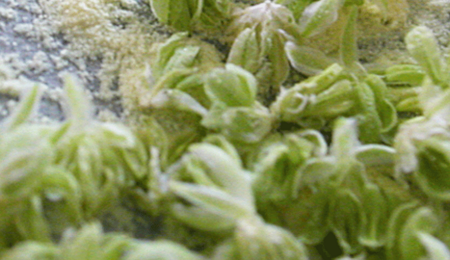Nutrition and Water Quality for Cannabis Cultivation
20 May 2019

In order to make your plants grow as planned, you need to create ideal conditions for them. The most important aspects include proper nutrients and high quality water. Those two things are closely related. Without water, plants would not be able to absorb the nutrients, and, on top of that, its quality may also influence the growing medium or fertilizers in one way or another.


How Plants Absorb Nutrients
Plants obtain nutrients through their roots, although to a certain extent, they can absorb them through their leaves, too. Every plant needs to have a properly developed and healthy root system in order to be able to receive enough nutrients. Furthermore, it is important for the growing medium to be suitable for the intake and storage of nutrients. As far as hydroponic growing is concerned, the growing medium in the default state does not contain any nutrients. The plants thus receive nutrients directly from nutrient solutions. When they are grown in soil, nutrients are contained in substrate. After watering, some nutrients dissolve in water enabling plants to absorb them through their roots. You can see that water significantly influences the process of nourishment of the plants. That is why its quality is so important. Healthy roots are the cornerstone of every good harvest. Never forget to keep them in appropriate living conditions. Roots undergo the best possible development and can absorb the most nutrients in temperatures just around 20 °C. They also need oxygen, which they absorb and use as prevention from root rot and other pathogens. Without access to oxygen, the roots start rotting off and they are not able to absorb nutrients from the growing medium. Water for watering, as well as nutrient solution, should both be oxygenated. You can either use an aquarium compressor or let a small circulator pump do the job. As soon as water starts to move, it automatically gets slightly oxygenated.
Importance of pH and EC
The pH and EC of water and growing substrate also have a great impact on the absorption of nutrients. If the pH or EC values are too low or too high, the plants cannot soak up nutrients the way they would under optimal circumstances. The pH value tells you how acidic or alkaline the water, the nutrient solution or the growing medium is. Some elements, e.g. calcium and magnesium, are more accessible for plants when the pH value is higher, whereas other elements, e.g. iron or zinc, are more accessible when the pH value is lower. For cannabis to absorb all the necessary elements in optimal amounts, it is recommended to keep the pH between 5.5 and 6.3 for hydroponic growing and between 5.8 and 6.5 for growing in soil. If the pH gets distinctively lower or higher, your plants do not absorb the nutrients evenly, which makes the unused ones accumulate in the medium, while the plants suffer because of shortage of those nutrients. A so-called nutrient lockout can occur (it is a situation when the nutrients are present, but the plant cannot absorb them), which can lead to substance imbalance, formation of toxic substances and creation of optimal conditions for pathogens. A regular check up of optimal pH level is incredibly important for successful harvest. Tap water is usually a bit alkaline, which means that its pH is over 7. Water from well or rain water is usually neutral, or a little acidic, with pH between 6.5 and 7. If you are using an electronic pH tester, do not forget to calibrate it regularly every month. PH electrodes also do not last forever and they should be replaced at least once a year. This maintenance is costly, but it is worth the money. You know, measuring pH is pretty much useless when it is not accurate. Another crucial factor for nutrient absorption is electrical conductivity – EC. This value tells you how many nutrients are contained in water, growing medium and nutrient solution. Cannabis plants can soak up dissolved nutrients with EC value up to 2.4 µS/cm2 or 1200 ppm (whichever unit of measurement you prefer). The conversion of EC to ppm can be done easily by multiplying the EC value by 500. If unrefined water from your source has EC 0.3 µS/cm2, you can provide the plants with up to 2.1 µS/cm2of nutrients in a ratio which they need. However, if the water from your source has EC of 0.7 µS/cm2, you can provide the plants only with 1.7 µS/cm2 of nutrients. If you want to find out what nutrients are contained in your unrefined water, you need to have it examined in a lab. Nevertheless, it can never have composition as good as the water you could prepare for your plants yourself. Thus, the lower the EC of your unrefined water is, the better nutrient solutions you can make.Chlorine in Water
If you use tap water and do not have any special water filter, you need to take into account that this kind of water contains chlorine. It is added to it as disinfectant to kill bacteria, viruses and other pathogens. That is surely good for hygienic reasons, not for the growing medium. The first problem lies in the fact that chlorine can damage weaker roots, and you definitely do not want that to happen. Another problem occurs when you are using some beneficial microorganisms. Not only does chlorine kill the pathogens, it also kills all the salutary molds and bacteria that you have carefully raised in your growing medium. Usage of mycorrhizal fungi, trichoderma or parasitic nematodes against pests is then less effective. Since chlorine is a gaseous element, it slowly evaporates. Lots of growers count on that. They simply have a water tank where they put water in advance and let chlorine evaporate. But how long does it take before all the chlorine is gone? Are 24 hours enough? There is no clear-cut answer, because there are lots of variables – the size of your tank, room temperature, water level and so on. The evaporation can be speeded up by using an aquarium compressor, or a circulator pump. Still, you can never be sure that the chlorine is completely absent. If you want to be 100% sure, you need to filter the water.Fertilization
At this point, no one probably doubts the importance of water quality for growing. No matter if you grow hydroponically or in soil. When you want to have a proper nutrient solution and allow your plants to absorb these nutrients, you need to measure the pH and EC values of clean water, then the same values of water with fertilizers in it and sometimes even the values of water that leaks out of the growing medium. Measure the pH and EC daily or every other day. This will give you a good overview of how much nutrients you supply your plants with and how much they use. Any deviations from ideal pH and EC values can be adjusted quickly. Let me just say a few more things about fertilization. As stated before, plants can absorb up to 2.4 µS/cm2 of nutrients. Do not forget, though, that the nutrients cannot stay too long in the growing medium. It is necessary to wash away nutrients that have not been used for some time and make way for new ones. If you grow in flowerpots, you must water them with so much liquid, so that one third of it leaks out – this way you replace all the water containing dissolved nutrients. Water your plants so heavily at least once a week. In case you are growing hydroponically, no matter if in flowerpots or different growing system, you should backwash the water regularly with clean water with modified pH. Do the backwash every seven or ten days – the same with the complete exchange of nutrient solution in your tank. Continually high EC levels and the absence of backwashing lead to the quality degradation of environment in your growing medium, which prevents the root system from further growth and causes damage to it. Furthermore, the pH then changes quite quickly, leading to other problems.



